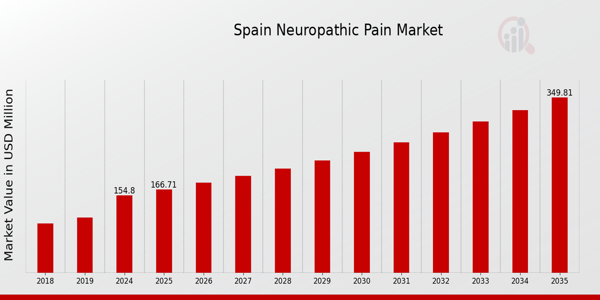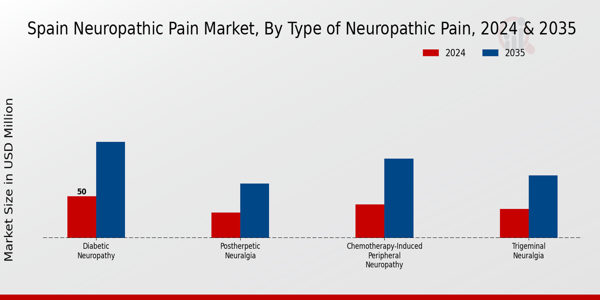Spain Neuropathic Pain Market Overview
As per MRFR analysis, the Spain Neuropathic Pain Market Size was estimated at 146.64 (USD Million) in 2023. The Spain Neuropathic Pain Market Industry is expected to grow from 154.8(USD Million) in 2024 to 349.8 (USD Million) by 2035. The Spain Neuropathic Pain Market CAGR (growth rate) is expected to be around 7.693% during the forecast period (2025 - 2035).
Key Spain Neuropathic Pain Market Trends Highlighted
The Spain neuropathic pain market is witnessing significant trends driven by various factors. One of the key market drivers is the rising prevalence of neuropathic pain conditions such as diabetic neuropathy and postherpetic neuralgia among the Spanish population. As the elderly population grows, the demand for effective pain management solutions increases.
Government health initiatives aimed at enhancing pain management services and improving patient care also play a crucial role in driving market growth. Additionally, advancements in pharmacological treatments and the introduction of neuropathic pain medications are creating new opportunities in the market.
In recent times, there has been a noticeable shift towards personalized medicine and alternative therapies, such as non-pharmacological treatment options, which are gaining popularity among patients. The Spanish healthcare system is slowly incorporating these innovative approaches, which are expected to complement traditional treatments.
Moreover, the increase in awareness about neuropathic pain and its impact on quality of life is leading to more significant patient advocacy and demand for better therapeutic options. Spain is also focusing on enhancing healthcare access and affordability, especially in rural areas, through telemedicine and digital health solutions.
This transition creates opportunities for patients to receive timely diagnoses and treatments. Furthermore, collaborations between healthcare providers, government bodies, and pharmaceutical companies are fostering research and development of new therapies tailored to the specific needs of the Spanish population.
Overall, the Spain neuropathic pain market is evolving, driven by patient-centric approaches and a growing emphasis on comprehensive pain management solutions.

Source Primary Research, Secondary Research, Market Research Future Database and Analyst Review
Spain Neuropathic Pain Market Drivers
Rising Prevalence of Neuropathic Disorders in Spain
Neuropathic illnesses are becoming more common in Spain, especially as the population ages. According to the Spanish National Institute of Statistics, over 30% of the population will be over 65 by 2030. Age-related neuropathic pain disorders including diabetic neuropathy and post-shingles pain are more common, according to this demographic trend.
Additionally, up to 8% of people in Spain have chronic pain disorders, according to the Spanish Society of Pain, which promotes improved diagnostic and treatment methods. The necessity for efficient treatment options in the Spain Neuropathic Pain Market Industry has been fueled by growing awareness and acknowledgment of neuropathic pain as a serious health concern.
The market is anticipated to grow considerably as the healthcare system adjusts to offer treatment that is suited to these demographic shifts.
Advancements in Pain Management Technologies
Technological advancements in pain management solutions are driving the Spain Neuropathic Pain Market. The Spanish Ministry of Health has allocated resources for Research and Development in novel therapeutic solutions such as neuromodulation devices and drug therapies.
For instance, the introduction of innovative transcranial magnetic stimulation techniques has shown significant promise in treating neuropathic pain, leading to a 25% improvement in pain scores in clinical trials. Organizations such as the Spanish Society of Anesthesia and Reanimation are endorsing these new techniques, amplifying their acceptance within medical practice, and thereby expanding the market for neuropathic pain treatments.
Increased Investment in Healthcare Infrastructure
The Spanish government is significantly increasing investment in its healthcare infrastructure, making it more equipped to handle complex health conditions such as neuropathic pain. Reports indicate that healthcare spending in Spain is projected to grow by about 6.5% annually through 2025.
This commitment is expected to enhance access to pain management services, making innovative therapies more widely available. Additionally, initiatives from organizations such as the Spanish Pharmaceutical Industry Association highlight the importance of equitable healthcare access.
As public hospitals and private clinics adopt more comprehensive pain management protocols, opportunities will arise for growth within the Spain Neuropathic Pain Market Industry.
Spain Neuropathic Pain Market Segment Insights
Neuropathic Pain Market Type of Neuropathic Pain Insights
The Spain Neuropathic Pain Market is characterized by various types of neuropathic pain, with a diverse segmentation that includes conditions such as Diabetic Neuropathy, Postherpetic Neuralgia, Trigeminal Neuralgia, and Chemotherapy-Induced Peripheral Neuropathy. Diabetic Neuropathy is notably prevalent in Spain, driven by the increasing rates of diabetes within the population, leading to a significant burden on healthcare resources.
Diabetic Neuropathy is notably prevalent in Spain due to increasing diabetes rates. Postherpetic Neuralgia is a major condition following shingles, especially in the aging population. Trigeminal Neuralgia requires improved diagnostics and treatments due to its severe facial pain. Chemotherapy-Induced Peripheral Neuropathy is increasingly recognized with rising cancer incidence.
Collectively, this variety of neuropathic pain types highlights the diverse therapeutic needs within the Spain Neuropathic Pain Market and points toward opportunities for innovative treatments and enhanced patient care solutions tailored to these specific conditions. The segment not only reflects the pain experiences of those affected but also drives ongoing research, clinical advancements, and, ultimately, market growth in addressing these pressing health issues.
As such, understanding these types of neuropathic pain is essential for targeted market strategies and effective healthcare solutions in Spain.

Source Primary Research, Secondary Research, Market Research Future Database and Analyst Review
Neuropathic Pain Market Treatment Type Insights
The Spain Neuropathic Pain Market is witnessing significant growth in the Treatment Type segment, which plays a crucial role in addressing the various challenges posed by neuropathic pain. Key categories within this segment include Medications, Physical Therapy, Surgical Procedures, and Electrical Stimulation.Medications are at the forefront, utilizing various pharmacological agents.
Physical Therapy promotes recovery and improves functionality. Surgical Procedures cater to those who do not find relief through conservative methods. Electrical Stimulation has gained traction as a non-invasive approach.
Each of these categories holds significant importance, with Medications generally dominating due to their wide accessibility and immediate effectiveness. The diversity in treatment options allows for a personalized approach to patient care, reflecting the dynamic landscape of the Spain Neuropathic Pain Market, driven by evolving patient needs and clinical advancements.
As healthcare resources in Spain continue to adapt to these demands, there will be ample opportunities for innovation and growth.
Neuropathic Pain Market Route of Administration Insights
The Route of Administration segment within the Spain Neuropathic Pain Market highlights critical pathways for delivering pain management therapies. The market encompasses various methods, including Oral, Topical, and Injectable, each serving distinct patient needs and preferences.
Oral administration is widely utilized due to its convenience. Topical treatments offer targeted relief with minimal systemic effects. Injectable solutions are significant for individuals requiring rapid pain alleviation.
The diversity of these routes addresses the varying severity of neuropathic pain and patient-specific factors, allowing for personalized therapy regimens. This versatility is expected to drive advancements in pharmacological formulations and enhance the effectiveness of pain management strategies in Spain, where the prevalence of neuropathic pain continues to be a growing public health concern.
Moreover, ongoing innovations in drug delivery systems are likely to bolster the adoption of these administration routes, aligning with the overall growth trajectory of the Spain Neuropathic Pain Market.
Neuropathic Pain Market End User Insights
The 'Spain Neuropathic Pain Market' has shown increasing relevance in its End User segment, primarily focused on hospitals, clinics, and home care settings. Hospitals play a crucial role in providing advanced therapeutic options for managing neuropathic pain. Hospitals provide advanced therapeutic options for neuropathic pain. Clinics offer outpatient services focusing on pain management. Home care services enable personalized patient care at home.
The need for specialized treatment in these institutions is prominent due to the rising prevalence of chronic pain conditions among the Spanish population, which has reached alarming statistics that necessitate targeted healthcare solutions. The growing aging population in Spain and the associated increase in neurological disorders present opportunities for these sub-sectors to innovate and expand their services.
Overall, the diverse requirements of the End User segment underline the critical need for an integrated approach to effectively manage neuropathic pain across multiple healthcare settings, contributing to the 'Spain Neuropathic Pain Market' statistics and growth trends.
Spain Neuropathic Pain Market Key Players and Competitive Insights
The Spain Neuropathic Pain Market is evolving significantly, reflecting the increasing awareness and demand for effective treatments for neuropathic pain conditions. Understanding competitive insights in this market is crucial for stakeholders aiming to navigate the intricate healthcare landscape efficiently. Numerous pharmaceutical companies are actively focusing on the development and commercialization of innovative therapies.
The market dynamics are shaped by various factors such as regulatory environments, patient demographics, and the integration of emerging technologies in the treatment paradigms. In this context, companies' ability to leverage their research and development capabilities alongside their operational strengths becomes paramount in establishing a competitive edge.
Teva Pharmaceutical Industries
Teva Pharmaceutical Industries maintains a strong presence in the Spain Neuropathic Pain Market, characterized by its comprehensive portfolio of pain management solutions. The company's extensive experience in the pharmaceutical sector allows it to benefit from established distribution networks and deep clinical insights, enabling it to respond effectively to the nuanced needs of the Spanish patient population.
Teva's strengths include its robust product development capabilities, commitment to innovation, and focus on accessible pricing strategies that enhance drug affordability. Furthermore, Teva's partnerships with healthcare professionals and institutions foster trust and reliability in its offerings, solidifying its foothold in the marketplace.
The company’s agility in clinical trials and product rollouts also allows it to address treatment gaps in a timely manner, ensuring that patients have access to necessary therapies.
Takeda
Takeda also plays a significant role in the Spain Neuropathic Pain Market, bringing to the table a range of advanced therapies and a strong focus on research and development. The company is recognized for its commitment to delivering innovative healthcare solutions that cater to the specific requirements of patients suffering from neuropathic pain.
Takeda's key products in this market include several pharmaceutical offerings known for their effectiveness in pain management. The company has established a solid market presence in Spain through strategic mergers and acquisitions, bolstering its capabilities to provide a diverse range of treatments.
Takeda's strengths lie in its ability to integrate cutting-edge research into its product development processes, ensuring that its therapies are both safe and efficacious. This strategic approach, combined with a deep understanding of local market dynamics, allows Takeda to maintain a competitive advantage in Spain and meet the evolving challenges posed by the neuropathic pain landscape effectively.
Key Companies in the Spain Neuropathic Pain Market Include
Spain Neuropathic Pain Market Industry Developments
Recent developments in the Spain Neuropathic Pain Market highlight various significant happenings. In August 2023, Teva Pharmaceutical Industries announced the launch of a new formulation aimed at improving treatment adherence among patients suffering from neuropathic pain.
Furthermore, Bristol Myers Squibb continued to expand its clinical trials in Spain, focusing on innovative treatments that address chronic pain conditions. Notably, in March 2023, Takeda announced a strategic partnership with Astellas Pharma to enhance their Research and Development capabilities in addressing neuropathic pain, demonstrating a commitment to expanding therapeutic options.
In terms of market growth, Eli Lilly and Novartis reported an increase in market valuation due to their recent product launches and ongoing studies in neuropathic pain management. The Spanish government's healthcare budget allocation has also increased funding for pain management initiatives, which supports the market's growth.
While there have been no recent notable mergers or acquisitions reported among the companies of interest within this specific market segment in Spain, the aforementioned collaborations and expansions indicate a positive trajectory for investment in combining innovative therapies for neuropathic pain.
Spain Neuropathic Pain Market Segmentation Insights
Neuropathic Pain Market Type of Neuropathic Pain Outlook
- Chemotherapy-Induced Peripheral Neuropathy
Neuropathic Pain Market Treatment Type Outlook
Neuropathic Pain Market Route of Administration Outlook
Neuropathic Pain Market End User Outlook
| Report Attribute/Metric Source: |
Details |
| MARKET SIZE 2018 |
146.64(USD Million) |
| MARKET SIZE 2024 |
154.8(USD Million) |
| MARKET SIZE 2035 |
349.8(USD Million) |
| COMPOUND ANNUAL GROWTH RATE (CAGR) |
7.693% (2025 - 2035) |
| REPORT COVERAGE |
Revenue Forecast, Competitive Landscape, Growth Factors, and Trends |
| BASE YEAR |
2024 |
| MARKET FORECAST PERIOD |
2025 - 2035 |
| HISTORICAL DATA |
2019 - 2024 |
| MARKET FORECAST UNITS |
USD Million |
| KEY COMPANIES PROFILED |
Teva Pharmaceutical Industries, Takeda, Novartis, Eli Lilly, BristolMyers Squibb, Horizon Therapeutics, Boehringer Ingelheim, Pfizer, Amgen, AbbVie, Astellas Pharma, Celegene, Sanofi, GSK |
| SEGMENTS COVERED |
Type of Neuropathic Pain, Treatment Type, Route of Administration, End User |
| KEY MARKET OPPORTUNITIES |
Growing aging population, Increased prevalence of diabetes, Advancements in pain management therapies, Rising awareness of neuropathic pain, Expansion of telehealth services |
| KEY MARKET DYNAMICS |
increasing prevalence of neuropathic conditions, growing elderly population, advancements in pain management therapies, rising awareness of neuropathic pain, strengthening healthcare infrastructure |
| COUNTRIES COVERED |
Spain |
Frequently Asked Questions (FAQ):
The Spain Neuropathic Pain Market is expected to be valued at 154.8 USD Million in 2024.
By 2035, the market is projected to reach a value of 349.8 USD Million.
The expected CAGR for the market from 2025 to 2035 is 7.693%.
Diabetic Neuropathy has the highest projected value at 115.0 USD Million by 2035.
Key players include Teva Pharmaceutical Industries, Takeda, Novartis, and Eli Lilly among others.
The market value for Postherpetic Neuralgia is expected to be 30.0 USD Million in 2024.
Chemotherapy-Induced Peripheral Neuropathy is expected to grow from 40.0 USD Million in 2024 to 94.8 USD Million by 2035.
Key challenges include regulatory hurdles and a lack of awareness about neuropathic pain treatments.
Trigeminal Neuralgia's market value is expected to increase to 75.0 USD Million by 2035.
Opportunities lie in the development of innovative treatment options and increasing investment in research and development.















